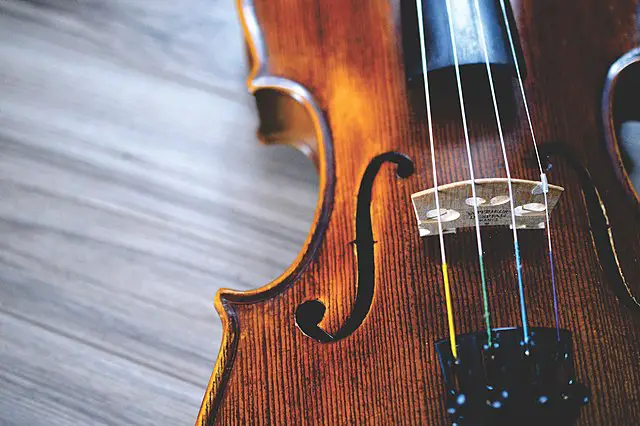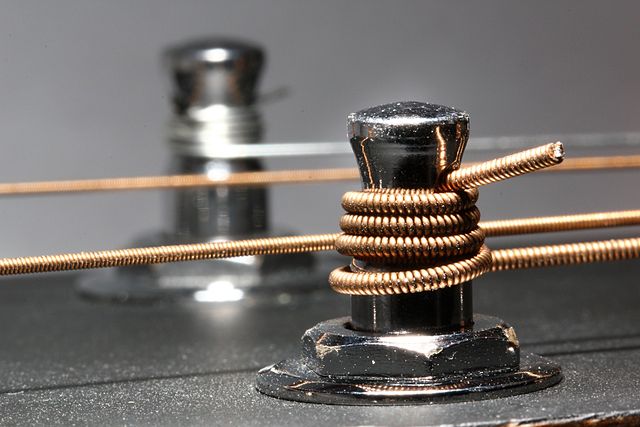Although both modern-day Guitars and Violins use metal strings, there are many differences to consider. Whilst it’s physically possible to place Guitar strings on the Violin and vice versa, strings are meticulously designed for the instrument in both dimensions and usage.
For example, the Violin is shorter, doesn’t have frets and is normally played with a bow. Therefore strings are designed and manufactured in line with this. Within this article, we examine the key differences between Violin strings and Guitar strings.
Summary
Violin strings are very different from guitar strings. They differ in shape, material, size, and number. This is why they produce different sounds and can’t be used interchangeably. So if you choose to use violin strings on your guitar or vice versa, the sound produced will be awful.
Table of Contents
What Are the Differences Between Violin Strings and Guitar Strings?
Although both the violin and the guitar are stringed instruments, the sound produced is different, and the strings on both instruments aren’t the same. Here are the main differences between violin and guitar strings.

Shape
The shape of Violin strings and Guitar strings are visually noticeable different. Violin strings are shorter because the violin’s neck is shorter than the guitar’s neck. Guitar strings also tend to be thinner than the ones used on a violin.
Violin strings are thicker due to the slower vibration created with the bow compared to the plucking technique on the Guitar. With increased mass, Violin strings vibrate slower than Guitar strings.
Material and design
Both violin and guitar strings are made of a core wrapped with wound metal or wire strands. The core design differs according to the manufacturer and sound preferences, and the winding on the string refers to how thin wire wraps around the core.
Violin strings are produced from different materials, including sheep intestines and steel. Cheap violin strings are made of nylon and other synthetic polymers.
Gut strings are more fragile and break down faster than steel and nylon strings. They’re also more expensive and are often used when playing baroque music.
Steel core strings are usually made of several steel strands that are twisted together, and most violin strings are flat-wound.
Guitar strings have a core that’s usually hexagonal to help the wire stay in place. There are also round-core guitar strings, but these tend to be more expensive. Wires can be flat-wound or round-wound around the string’s core.
Flat-wound guitar strings are less common in acoustic guitars and are usually found on electric ones. They’re usually used by bass and jazz players, and they feature a thin layer of polished ribbon to produce a mellow sound.
Round-wound guitar strings are more common than flat-wound ones. They’re livelier and more responsive to help make the tunes brighter. This is why they can be used for any music genre, including jazz.
Number
On the violin, you have four strings, and each one of them produces a specific pitch. They’re G, D, A, and E strings when they’re arranged from lowest to highest, and they exist with a perfect fifth.
There are usually six strings arranged from lowest to highest on the guitar. They’re arranged from E, A, D, G, B to a high E, with a perfect fourth that exists between each note.
According to this order, the strings of violins are arranged in exactly the opposite direction or matter of the guitar strings.
There are only four strings on a bass guitar, although there are some bass guitars that have five or six strings, just like the classic and acoustic ones.
Tuning
On the guitar, there are tuning pegs, and each one of them corresponds to one of the strings. By turning these pegs, you’re able to tune the guitar and change the pitch.
A violin has fine tuners, in addition to the pegs. Turning the peg can result in a massive change in the pitch, so you can only use those when the strings are extremely out of tune or noticeably loose.
However, in most cases, you can use the fine tuners for adjustment, which only change the pitch a little bit.
This is why tuning a violin is harder than tuning a guitar, as any slight turning of the peg will result in a significant change.
Response
When you play the violin, you need to move the bow across the strings while positioning your finger to produce the right pitches. In very few cases, the violinist will pluck the strings. A guitar is either strummed or plucked, using your fingers or picks.
Due to the design and shape of the strings, Guitar strings require more pressure from the player in order to generate the note. This is why most beginner guitarists suffer from finger pain. On the other hand, pressing the strings on the violin is slightly easier. This is partly due to the fact guitar music often incorporates chords that require complex fingering positions.
The violin’s strings are more sensitive to touch and will produce a sound with the slightest movement from the bow. This means that violin strings have a quicker response time than guitar strings.
Can Guitar Strings Be Used on the Violin?
Guitar strings should not be used on the Violin. It would be difficult to tune and fit the strings, and the sound produced would be terrible. This is for several reasons:
- The guitar’s strings are thinner than the violin’s strings, and they won’t produce the right tune or pitch.
- The strings are longer than the ones found on a violin.
- Guitar strings are round-wound, while violin strings are flat-wound. Since the bow is designed to work on these flat-wound strings, using guitar strings instead can damage your bow.

Are Violin Strings or Guitar Strings More Expensive?
In general, the average price of Violin strings is more than guitar strings. This is related to more expensive raw materials and a more complex manufacturing process.
Moreover, more guitar strings are available for purchase than violin strings, mainly because the guitar is more versatile and popular. Guitars are more suitable for beginners than violins because the playing posture is easier, and you can easily produce a good sound from a guitar compared to a violin.
Guitars are also used in various music genres like country, Latin, jazz, hip hop, and rock, while violins are used in fewer genres like classic and country music. This also makes guitar strings more affordable.
Do Violin Strings or Guitar Strings Last Longer?
Violin strings tend to last longer than Guitar strings. This is because they’re flat-wound, and the smooth movement of the bow doesn’t cause much damage, even with regular play.
Guitar strings are round-wound and fretted against the frets that help you produce the right pitch. They’re either strummed or plucked, and these movements usually result in faster wear and tear.
With regular use, a violinist should expect to have their instrument examined every 9 to 12 months, and in most cases, this is when you’ll have to consider replacing your strings. High-quality strings tend to last longer than the cheap ones.
For a guitarist, the three-month mark usually makes more sense. After three months, you’ll notice that your instrument isn’t producing the sound you expect, and this tells you that you should have the strings replaced.
Ignoring maintaining and examining your strings can result in several issues.
- Your instrument won’t sound the way it should which affects your performance.
- You’ll face tuning difficulties, regardless of how much you spend on fine-tuning your instrument.
- You have to use more pressure while you’re playing your instrument, which can be a problem whether you’re playing the violin or the guitar.
- The string can be broken while you’re playing it. Since these strings mostly feature a metal core, the flying string can be dangerous.
What Are the Best Violin and Guitar Strings on the Market?
Finding good violin and guitar strings isn’t that challenging because there are lots of good options on the market.
If you’re looking for high-quality violin strings, you can check out the Thomastik-Infeld 135 Dominant Violin Strings. Thomastik-Infeld are well known in the Violin space for producing excellent quality strings at a decent price point.
If you’re looking for gut strings, research the Pirastro Passione Solo Violin Strings. Gut strings are less common and are normally reserved for the advanced player (as they tend to be on the pricier side). However, they are worth considering, as many Violinists think gut strings project more and produce a warmer timbre.
To replace your acoustic guitar strings, we recommend that you check out the Elixir 16052 Strings Phosphor Bronze Acoustic Guitar Strings. They’re made of phosphor bronze wrap wire with a thin protective coating to protect them from corrosion and damage. Given that Guitar strings break regularly, we’d recommend spending slightly more initially since good quality strings will last far longer.
If you have an electric guitar, you can check out the D’Addario EXL110-3D Nickel Wound Electric Guitar Strings. They’re made of nickel-plated steel with a hexagonal carbon steel core to resist premature fret wear.
Wrap Up
Violin strings and guitar strings might appear similar, but they’re different in many aspects.
Using violin strings on your guitar or vice versa won’t work because they’re made and designed differently. As a matter of fact, if you choose to use guitar strings on your violin, you’ll probably damage your bow.
Violin strings tend to be more expensive than guitar strings, but they also last longer. However, whether you have a guitar or a violin, you need to check your instrument and examine the strings to have them replaced regularly.
